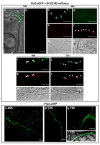The SCO2102 Protein Harbouring a DnaA II Protein-Interaction Domain Is Essential for the SCO2103 Methylenetetrahydrofolate Reductase Positioning at Streptomyces Sporulating Hyphae, Enhancing DNA Replication during Sporulation
- PMID: 35563376
- PMCID: PMC9099993
- DOI: 10.3390/ijms23094984
The SCO2102 Protein Harbouring a DnaA II Protein-Interaction Domain Is Essential for the SCO2103 Methylenetetrahydrofolate Reductase Positioning at Streptomyces Sporulating Hyphae, Enhancing DNA Replication during Sporulation
Abstract
Streptomyces DNA replication starts with the DnaA binding to the origin of replication. Differently to most bacteria, cytokinesis only occurs during sporulation. Cytokinesis is modulated by the divisome, an orderly succession of proteins initiated by FtsZ. Here, we characterised SCO2102, a protein harbouring a DnaA II protein-protein interaction domain highly conserved in Streptomyces. The ΔSCO2102 knockout shows highly delayed sporulation. SCO2102-mCherry frequently co-localises with FtsZ-eGFP during sporulation and greatly reduces FtsZ-eGFP Z-ladder formation, suggesting a role of SCO2102 in sporulation. SCO2102 localises up-stream of SCO2103, a methylenetetrahydrofolate reductase involved in methionine and dTMP synthesis. SCO2102/SCO2103 expression is highly regulated, involving two promoters and a conditional transcription terminator. The ΔSCO2103 knockout shows reduced DNA synthesis and a non-sporulating phenotype. SCO2102-mCherry co-localises with SCO2103-eGFP during sporulation, and SCO2102 is essential for the SCO2103 positioning at sporulating hyphae, since SCO2103-eGFP fluorescent spots are absent in the ΔSCO2102 knockout. We propose a model in which SCO2102 positions SCO2103 in sporulating hyphae, facilitating nucleotide biosynthesis for chromosomal replication. To the best of our knowledge, SCO2102 is the first protein harbouring a DnaA II domain specifically found during sporulation, whereas SCO2103 is the first methylenetetrahydrofolate reductase found to be essential for Streptomyces sporulation.
Keywords: DnaA; SCO2102 DnaA homologue; SCO2103 MTHFR; Streptomyces; cell division; differentiation; sporulation.
Conflict of interest statement
The authors declare no conflict of interest.
Figures










Similar articles
-
The SepF-like proteins SflA and SflB prevent ectopic localization of FtsZ and DivIVA during sporulation of Streptomyces coelicolor.Biochem Biophys Res Commun. 2023 Feb 19;645:79-87. doi: 10.1016/j.bbrc.2023.01.021. Epub 2023 Jan 14. Biochem Biophys Res Commun. 2023. PMID: 36680940
-
FtsZ phosphorylation pleiotropically affects Z-ladder formation, antibiotic production, and morphogenesis in Streptomyces coelicolor.Antonie Van Leeuwenhoek. 2023 Jan;116(1):1-19. doi: 10.1007/s10482-022-01778-w. Epub 2022 Nov 16. Antonie Van Leeuwenhoek. 2023. PMID: 36383329 Free PMC article.
-
Generation of a non-sporulating strain of Streptomyces coelicolor A3(2) by the manipulation of a developmentally controlled ftsZ promoter.Mol Microbiol. 2000 Nov;38(4):737-49. doi: 10.1046/j.1365-2958.2000.02177.x. Mol Microbiol. 2000. PMID: 11115109
-
Bacterial replication initiator DnaA. Rules for DnaA binding and roles of DnaA in origin unwinding and helicase loading.Biochimie. 2001 Jan;83(1):5-12. doi: 10.1016/s0300-9084(00)01216-5. Biochimie. 2001. PMID: 11254968 Review.
-
Streptomyces and Escherichia coli, model organisms for the analysis of the initiation of bacterial chromosome replication.Arch Immunol Ther Exp (Warsz). 2002;50(6):393-8. Arch Immunol Ther Exp (Warsz). 2002. PMID: 12546065 Review.
Cited by
-
Peptidoglycan-reshuffling proteins SCO0954, SCO1758, SCO4439, and SCO4440 modulate the formation of wall-deficient cells in Streptomyces coelicolor under hyperosmotic sucrose stress.Sci Rep. 2025 Sep 1;15(1):32112. doi: 10.1038/s41598-025-15457-z. Sci Rep. 2025. PMID: 40890197 Free PMC article.
-
The DeoR-like pleiotropic regulator SCO1897 controls specialised metabolism, sporulation, spore germination, and phosphorus accumulation in Streptomyces coelicolor.Commun Biol. 2024 Nov 7;7(1):1457. doi: 10.1038/s42003-024-07164-8. Commun Biol. 2024. PMID: 39511385 Free PMC article.
-
Bacterial Regulatory Proteins.Int J Mol Sci. 2022 Jun 20;23(12):6854. doi: 10.3390/ijms23126854. Int J Mol Sci. 2022. PMID: 35743293 Free PMC article.
References
-
- Hopwood D.A. Streptomyces in Nature and Medicine: The Antibiotic Makers. Oxford University Press; New York, NY, USA: Oxford, UK: 2007.
MeSH terms
Substances
Grants and funding
LinkOut - more resources
Full Text Sources

